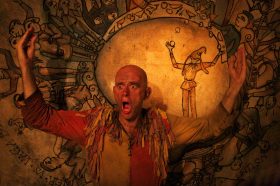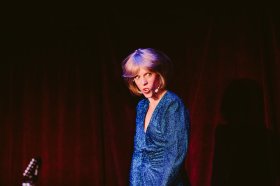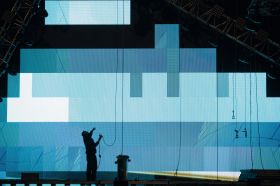Natasha Kusen and Andrew Killian in Petit Mort from Chroma. Image by Paul Scala.
This most exciting triple bill is very demanding for the dancers as it requires them to be familiar with three very different styles of choreography — some of which is very athletic and seemingly almost physically impossible.
The programme opened with a bang with choreographer Wayne McGregor’s 2006 blinding, futuristic Chroma performed to the relentless music of Joby Talbot and Jack White. The work is about colour, or the lack thereof. Inspired by Pawson’s architectural writings on the essential ‘freedom space’, McGregor says Chroma explores the capacity of choreography to inhabit the body as a frequency of colour – in freedom from white. John Pawson’s set is cream/white with a black square. Carter’s vivid lighting changes the box into different primary colours while the dancers are their own colour shifts, dressed as they are in unisex pastel-toned tunics with spaghetti straps.
The dancers are required to be seemingly boneless, yet have a laser-sharp long line and ‘attack’. McGregor’s choreography also requires a very flexible back. At times the dancers resemble mysterious Anthony Gormley sculptures. There is an emphasis on the line of arabesque and an idiosyncratic use of the elbow in certain sections.
For me, Stephen Bayne’s ‘Art to Sky’ was the least successful in this mixed programme. The music is Tchaikovsky’s romantic homage to Mozart’s classicism. It is danced gloriously and has some excellent moments but just lacks the final polishing touch.
The set was timeless, gesturing to the arches of a bridge or large building. I loved Rachel Burke’s marvellous use of dappled lighting, but was disappointed in Hugh Coleman’s excessively casual clothes for the men that rather clashed with the lovely designs for the women.
There is a superb pas de deux that will probably become a gala party piece. You can see the classical influence with allusions to the Petipa/Ivanov ‘Swan Lake’ in the patterns and lines of the choreography for the corps de ballet. Some of the choreography is very fiddly, filigree and complicated. There is also a section similar to the Rose Adagio, but for a woman and three not four men (other of my colleagues were reminded of Manon). Also included are references to Coppelia, with the doll-like women on pointe section.
There was a rather formal atmosphere and emphasis on rigid, rather regal uptight carriage. Bayne’s choreography included some difficult high Bolshoi style lifts. Rudi Hawkes had a very showy and effective solo, but the showstopper would have to be the luminous, lyrical pas de deux (I saw Leanne Stojmenov and Daniel Gaudiello).
After interval came two of Killian’s short ‘Black and White’ ballets to Mozart: ‘Petit Mort’ and ‘Sechs Tanze’ (‘Little Death’ and ‘Six dances’). Czech Kylian was for years the star director of Nederlands Dans Theater. Brian Cousins was the featured solo pianist and gave a luminous performance.
Musical director, Nicolette Fraillon, enthusiastically and rigorously conducted the Australian Opera and Ballet Orchestra through the Mozart and the other musical challenges magnificently. There was an atmosphere of danger for ‘Petit Mort’ – six hunky men in ‘Mozartian underwear’ swishing swords walking backwards then running with a death-like black cloth to reveal the women. The swords were also at times wrapped around the neck and picked up with the toes — Kylian’s way of emphasising the dangers underneath the surface of a relationship.
There’s a playful section with five women in mysterious black dresses that are detachable and that two of the men are dying to try on too. There is an exquisite, athletic, very demanding pas de deux at one point and marvellous use of dappled and /or golden lighting at others. Sometimes the dancers were frozen in sculptural tableaux or like puppets being manipulated.
In ‘Sechs Tanze’, the dancers were again in Mozartian underwear with wigs and white-face. It was far more slapstick in feel, demanding spot-on comic timing for its joyous lustiness. Challenging, engaging and fascinating this was a wickedly delightful way to finish an evening full of amazing choreographic invention.
Rating: 4 out of 5 stars
Chroma
Australian Ballet
Conductor (for all performances): Nicolette Fraillon
Chroma
By Wayne McGregor
With Amy Harris, Andrew Wright, Brett Simon, Calvin Hannaford, Chengwu Guo, Dana Stephensen, Juliet Burnett, Kevin Jackson, Robyn Hendricks, Simon Plant
Art to Sky
By Stephen Bayne
With Leanne Stojmenov, Daniel Gaudiello, Ako Kondo
Petit Mort and Sechs Tanze
By Jiri Kylian
With Andrew Killian, Charles Thompson, Cristiano Martino, Joseph Chapman, Kevin Jackson,
Richard House, Ako Kondo, Alice Topp, Amber Scott, Ingrid Gow, Juliet Burnett, Lana Jones, Benedicte Bemet, Eloise Fryer, Imogen Chapman, Natasha Kusen, Calvin Hannaford, Cameron Hunter, Francois-Eloi Lavignac, Rohan Furnell
Sydney Opera House, Bennelong Point
www.australianballet.com.au
9 – 17 May
Arts Centre, State Theatre, St Kilda Rd
6 – 14 June





